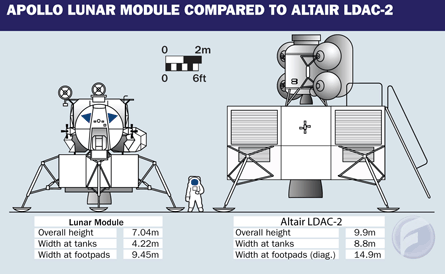NASA has sketched out the development timetable for its return-to-the-Moon Constellation programme's Altair lunar lander, aiming towards a long-term target of an unmanned June 2018 in-orbit propulsion test in preparation for a manned Moon mission in 2020.
An Altair conceptual design contract request for proposals, published on 28 January, calls for submissions from industry by 27 February.
According to a December 2008 pre-proposal conference presentation, multiple conceptual design contracts worth at least $42.2 million over four years are to be awarded in June. This year and 2010 will see "base awards" of $1.6 million and $5.6 million respectively. Then, in 2011, there is an "option one" award of $15 million. In 2012 "option two" is worth $20 million.
The presentation also gives a design, development, test and evaluation award date of 2013. The DDT&E work is likely to bridge the gap between the preliminary design review and the June 2018 test.
Leading up to that design review will be the system definition review, which the RFP says will end by March 2012. Preceding that by a year will be the system requirements review, with the Constellation's lunar capability system requirements review 18 months before that. Its preceding concept review was in June 2008.
Starting at the same time as this year's lunar capability system requirements review in July, after the contract awards, will be the six-month long trade analysis cycle (TAC)-1. This will involve "high-level vehicle architecture, configuration" analyses, retreading some of what took place during the lander design analysis cycles (LDAC) one through three.
 |
|---|
The agency's Altair project office is to finish LDAC-3 this March. It is actually the fifth design cycle as the project office's LDAC-1 and -2 both had "delta" processes. The LDAC-1 delta was to optimise the lander for cargo and the second involved revising the lander's avionics architecture. The end of LDAC-3 will be overlapped by the requirements analysis cycle, which ends in time for the lunar capability system requirements review.
After TAC-1 will be TAC-2, bringing the architecture, configuration studies to completion by June 2010. From then on every six months will see a new LDAC, namely four through eight. The LDAC-5 and -7 will overlap the system design and system requirements reviews.
NASA has already carried out one lunar lander study with industry. A November 2008 Broad Area Announcement Lunar Lander Study competition saw a total of $1.5 million in contracts to five companies including Seattle-based Andrews Space, Northrop Grumman and Odyssey Space Research. The study's goal was to obtain industry input into NASA's "study philosophy" and create a team able to work "together toward a common [NASA]-led design". Alternative industry design concepts were also welcome.
This work followed a multiple NASA centre effort that took place from April to August 2006 called the Preparatory Lunar Lander Study. It examined 30 different concepts and focused on seven.
Source: Flight International


























